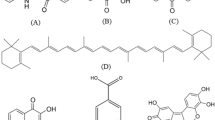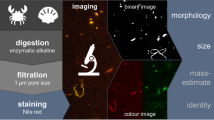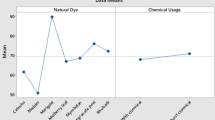Abstract
Two methods of analysis of organic components of colour layers of art works have been tested: IR microspectroscopy of indigo, Cu-phthalocyanine, and Prussian blue, and MALDI-TOF-MS of proteinaceous binders and a protein-containing red dye. The IR spectra distortion common for smooth outer surfaces and polished cross sections of colour layer of art works is suppressed by reflectance measurement of microtome slices. The detection limit of the three blue pigments examined is ~0.3 wt% in reference colour layers in linseed oil binder with calcite as extender and lead white as a drying agent. The sensitivity has been sufficient to identify Prussian blue in repaints on a Gothic painting. MALDI-TOF-MS has been used to identify proteinaceous binders in two historical paintings, namely isinglass (fish glue) and rabbit glue. MALDI-TOF-MS has also been proposed for identification of an insect red dye, cochineal carmine, according to its specific protein component. The enzymatic cleavage with trypsin before MALDI-TOF-MS seems to be a very gentle and specific way of dissolution of the colour layers highly polymerised due to very long aging of old, e.g. medieval, samples.





Similar content being viewed by others
References
Melessanaki K, Papadakis V, Balas C, Anglos D (2001) Spectrochim Acta B 56:2337–2346
Burgio L, Clark RJH, Theodoraki K (2003) Spectrochim Acta A 59:2371–2389
Burgio L, Clark RJH (2000) J Raman Spectrosc 31:395–401
Vandenabeele P, Wehling B, Moens L, Edwards H, De Reu M, Van Hooydonk G (2000) Anal Chim Acta 407:261–274
Ackacha MA, Połeć-Pawlak K, Jarosz M (2003) J Sep Sci 26:1028–1034
Puchalska M, Orlinska M, Ackacha MA, Połeć-Pawlak K, Jarosz M (2003) J Mass Spectrom 38:1252–1258
Maier MS, Parera SD, Seldes AM (2004) Int J Mass Spectrom 232:225–229
Kuckova S, Grygar T, Hradil T, Hradilova J (2003) J Solid State Electrochem 7:706–713
Novotna P, Pacakova V, Bosakova Z, Stulik K (1999) J Chromatogr A 863:235–241
Lang PL, Orna MV, Richwine LJ, Mathews TF, Nelson RS (1992) Microchem J 46:234–248
Van den Berg JDJ, Vermist ND, Carlyle L, Holcapek M, Boon JJ (2004) J Sep Sci 27:181–199
Spyros A, Anglos D (2004) Anal Chem 76:4929–4936
Keune K, Boon JJ (2004) Anal Chem 76:1374–1385
Pitthard V, Finch P, Bayerová T (2004) J Sep Sci 27:200–208
Regert M (2004) J Sep Sci 27:244–254
Colombini MP, Modungo F (2004) J Sep Sci 27:147–160
De la Cruz-Canizares J, Doménech-Carbó MT, Gimeno-Adelantado JV, Mateo-Castro R, Bosch-Reig F (2004) J Chromatogr A 1025:277–285
Carbini M, Stevanato R, Rovea M, Traldi P, Favretto D (1996) Rapid Commun Mass Spectrom 10:1240–1242
Chiavari G, Gandini N, Russo P, Fabbri D (1998) Chromatographia 47:420–426
Bonaduce I, Colombini MP (2003) Rapid Commun Mass Spectrom 17:2523–2527
Challinor JM (2001) J Anal Appl Pyrol 61:3–34
Mateo-Castro R, Gimeno-Adelantado JV, Bosch-Reig F, Doménech-Carbó A, Casas-Catalán MJ, Osete-Cortina L, De la Cruz-Canizares J, Doménech-Carbó MT (2001) Fresenius J Anal Chem 369:642–646
Makes F (1988) Enzymatic consolidation of the portrait of Rudolph II as “Vertumnus” by Giuseppe Arcimboldo with a new multi-enzyme preparation isolated from Antarctic krill (Euphausia superba), Acta Universitatis Gothoburgensis, Sweden
Beutel S, Klein K, Knobbe G, Königfeld P, Petersen K, Ulber R, Scheper T (2002) Biotechnol Bioeng 80:13–21
Hynek R, Kuckova S, Hradilova J, Kodicek M (2004) Rapid Commun Mass Spectrom 18:1–5
Ma Y, Lu Y, Zeng H, Ron D, Mo W, Neubert TA (2001) Rapid Commun Mass Spectrom 15:1693–1700
Berrie HB (1997) Prussian blue. In: Fitzhugh EW (ed) Artist’s pigments, a handbook of their history and characteristics, chap. 7, vol 3. National Gallery of Art, New York, pp 191–217
Newman R (1979) JAIC 19:42–62
Acknowledgements
The work was supported by Grant Agency of Czech Republic (project number 203/04/2091). We thank to restorers K. Stretti, D. Frank, and J. Hamsík (Academy of Fine Arts in Prague, Czech Republic) for providing samples, Tatyana Bayerova (University of Applied Arts, Vienna, Austria), for an inspiring discussion about IR spectroscopy in artwork analysis, and Ladislava Kratinova and Jindrich Martinek (First Faculty of Medicine, Charles University, Prague, Czech Republic) for cutting thin layers.
Author information
Authors and Affiliations
Corresponding author
Rights and permissions
About this article
Cite this article
Kuckova, S., Nemec, I., Hynek, R. et al. Analysis of organic colouring and binding components in colour layer of art works. Anal Bioanal Chem 382, 275–282 (2005). https://doi.org/10.1007/s00216-005-3108-5
Received:
Revised:
Accepted:
Published:
Issue Date:
DOI: https://doi.org/10.1007/s00216-005-3108-5




